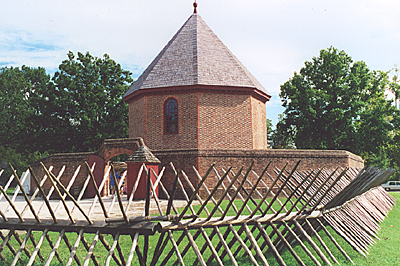 Magazine
Magazine
The octagonal brick magazine was built in 1715 and currently displays a number of firearms. When we attempted to enter, we entered the ground floor, but did not ascend the steep and narrow stair case due to the sheer number of people already upstairs.
Abatis surrounds the magazine, lending a particularly martial air to the building. The building, by the way, is the original.
Market Square
This open area is for the display of wares from a variety of vendors. Sadly, it stocked hats, muskets, and other rubber tomahawk-type goods that looked imported. The sellers were in period costume, though.
Harness and Saddlemaker
The docent, in character, pitched his shop as the finest in the district, and answered any questions you might have. I didn't, but it was worth a look. His assistant was making something in the background.
We swung around the back of the church and into a shady lane. We started to see private houses, so this is about the demarcation line of Colonial Williamsburg. We turned right to the Wythe House.
Wythe House
George Wythe was a pretty popular guy. He was a lawyer so learned, he taught Thomas Jefferson. He was a signer of the Declaration of Independence, and George Washington used his house as a headquarters for at least one night prior to Yorktown.
The gatekeeper lets you in on the side every so often. A different costumed interpreter provides a seven-minute lecture on the brilliance of Wythe in an outdoor arbor. Thankfully, you do not have to take a tour of the gardens, outbuildings, and house. You can poke around at your own pace, and various docents are there to answer questions and indeed, spontaneously provide information.
The Windmill and Exiting
As it was now about 5pm, when all the buildings close, we made our way back to the spot where the shuttle would be, passing Robertson's Windmill as we walked. Since there was no shuttlebus, we took the path back to the Visitor's Center. It's a five minute walk.
At the Visitor's Center, we headed for the bookshop, picking up a couple books for later.
Note that although the buildings close at 5pm, the actual town remains open for walking and sightseeing, plus various outdoor lectures, until 9pm. As I noted before, if you take advantage of all the various historical interpreters who provide talks and demonstrations, you could really spend three days poking around in every building.
We toured Colonial Williamsburg in six hours, and that provided a wonderful overview. In many ways, it reminds me of the Louvre in Paris--so much great art that after five or six hours, you start to become jaded. That's how well done it is.
Colonial Williamsburg is a marvelous stop. You might wince at the price of admission, but after spending six hours and poking around the wonders of 1774, you won't mind the pricetag when you consider all that they have preserved, and all that they are maintaining.
More Colonial Williamsburg
- Introduction
Governor's Palace
Into Town: Shops
Abby Aldrich Rockefeller Folk Museum
Arms Magazine Area
Where to Stay, Eat, and Play
Back to List of Historic Sites
Back to Travel Master List
Back to MagWeb Master List of Magazines
© Copyright 2003 by Coalition Web, Inc.
This article appears in MagWeb (Magazine Web) on the Internet World Wide Web.
Other articles covering military history and related topics are available at http://www.magweb.com